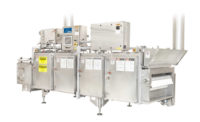
The Bonduelle Group, suppliers of canned vegetables, deep-frozen vegetables and processed salads, modernized and expanded its cold-storage facilities in Estrées, France. In the refrigeration plant of the existing Bonduelle facilities, it replaced the previous refrigerant R22 (known for its great ozone depletion potential) by the natural alternative ammonia (R717). Meanwhile, Bonduelle constructed a new 35-meter-high cold-storage facility that offers around 24,000 pallet storage slots and is equipped with advanced refrigeration technology. The company awarded GEA Refrigeration France with the refrigeration contracts for upgrading the old plant, as well as for the new high-bay storage facility.
25% efficiency gain in existing refrigeration plant
At Bonduelle, it was possible to achieve immense energy savings with the existing refrigeration plant alone. During replacement of R22 by ammonia, GEA not only converted the refrigeration systems during uninterrupted operation, but GEA’s customer and refrigeration specialists also equipped the old air coolers with frequency inverters. The speed of the fans on the cooling units is controlled according to actual cooling requirements. On the whole, the new measures resulted in 25% efficiency improvements.
Energy consumption at half levels for the new facilities
GEA implemented the refrigeration technology for the new, fully automatic high-bay cold-storage facilities with even greater efficiency gains. Even with its capacity of 24,000 storage slots, the pallet facility operates with cooling duty of a mere 2,100 kW-provided by two screw-type GEA YR-Y2655S-28 ammonia refrigeration units that provide temperatures of –28°C. These units support five GEA Goedhardt air coolers, which are designed to stimulate the thermo-syphon effect, blow cold air coming from the ceiling downwards and assure effective penetration of the cold-storage unit, with a volume of about 150,000 m³.
Designers of the solution took care that the shelf rows, with their 14 storage levels, as well as the six storage and retrieval systems, would have minimal influence on temperature distribution.
The dedicated air-flow system induces a “refrigeration lake,” which ensures minimal temperature stratification results, and that the plant reliably maintains the required storage temperature of -20°C. It is essential here to provide air movement with minimal flow speed while preventing hotspots at the same time. The implemented solution assures the required temperature with an air-outlet temperature of only –25°C. Frequency inverters on the fans and speed-controlled screw compressors ensure demand-driven operations and great efficiency in partial-load operating zones.
The refrigeration principle implemented for Bonduelle had earlier been installed in a high-bay, deep-freeze facility, where it proved its effectiveness. This deep-freeze system has been in operation since spring of 2011, during which consumption of only 15 kWh/(m³ a) suffices, in comparison to requirements of around 40 kWh/(m³ a) for comparable, conventional large-scale cold-storage plants.






